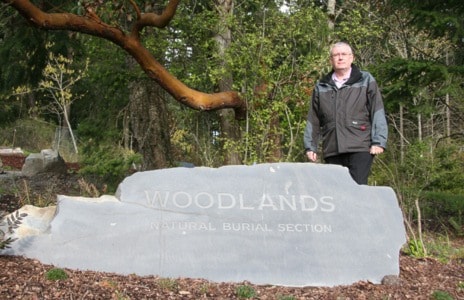More and more people are starting to consider what they want to happen with their bodies after they die.
Some are deciding that their end-of-life plan should be consistent with the way they live their life.
Victoria is a leader in the green burial movement, breaking ground on a subject that has, for many years, been considered morbid.
"A lot of people are making sustainable living choices, and this is a deathstyle choice,” says Brandy Gallagher, Executive Director of O.U.R. (One United Resource) Ecovillage in Shawnigan Lake. “We always talk about the cradle to grave cycle with our resources. Why not have that conversation about humans in the same way?” Gallagher asks. “We’re really trying to bring home the idea that end-of-life planning is a family and community process.”
O.U.R. Ecovillage just launched the Commemorative Legacy Project and officially opened its commemorative conservation scattering grounds on its 25 acre parcel of land on March 21. About one third, or almost nine acres, have been given to The Land Conservancy of B.C. to be protected in perpetuity as a sacred space to celebrate life and death.
“In the end-of-life planning process, people have the choice to have their remains cremated and brought here to be scattered or placed in the earth. On that spot a fruit or forest tree will be planted,” Gallagher said. “If having a viewing, no embalming can be involved, or if it is, it must use eco-appropriate embalming fluids, which are readily available on the market.”
The container for the ashes must also be made from sustainably harvested, organic materials. Because there are no bodies placed in the ground, there is no risk of the area filling up like a conventional cemetery and the carbon footprint from maintenance and landscaping is significantly reduced.
Although natural gas is used in the process of cremation, Don Morris, Outreach coordinator for the Green Burial Council says its carbon footprint is much lower than conventional burial.
“Cremation is the simplest solution. It’s the least complicated, least expensive and it’s efficient,” says Morris.
“But with a direct green burial, you really are donating your body after death to the earth to compost and bring about new life. Some people find meaning in doing so.”
B.C. has the highest cremation rate in Canada at more than 80 per cent. In Victoria, that rate is even higher at around 90 per cent— the highest rate in North America, according to Stephen Olson, executive director of the Royal Oak Burial Park. But not everyone is comfortable with the idea of cremation, and there are green options for them as well.
Since 2008, the Royal Oak Burial Park has been offering green burial services and almost 50 have taken place so far. It was the first cemetery in Canada to offer green burial services. A 0.4 acres section is Phase 1 of the internment zone called the Woodlands. It currently has space for 255 graves.
Phase 2 is under development to the immediate southwest, and will bring the total space allotted to one acre out of 134 total acres. In its master plan, the Royal Oak Burial Park has dedicated 50 per cent of all undeveloped land to natural burials and 50 per cent to more conventional burials.
With Green Burial, the body is buried in a simple, sustainably harvested soft wood casket or a shroud made from natural fibres. It is placed in a grave without the standard concrete grave liner. The plot is filled in and a leaf mulch mixture is placed on top. Native grasses, shrubs and trees are then planted on the site. There is no grave marker. Names and dates can be inscribed on one of six commemorative boulders in the area.
“The end result with green burial is that the section becomes reforested in an area that had been previously cleared,” Olson says.
The Woodlands border on to a rocky forest, which will grow with each grave that gets filled. The gravel roads will be removed and a footpath will be installed meandering throughout the section.
Each grave site will have a corresponding GPS locator for family and friends who want to pay homage at each grave site.There is considerably less maintenance required in this type of green burial internment zone compared to a conventional cemetery.
“The response has been tremendous,” Olson says. “Since we were the first in Canada, we had no idea what the usage would be. Now we’re convinced this is a trend and not a fad. More and more people, especially the younger generations feel that it makes more sense.”
Olson says that what is now considered a conventional funeral had its start back in the American Civil War.
“Soldiers were so far from home and in order to return their bodies home for burial, they started embalming.”
While the concept of Green Burial seems to be new to most people, Olson says it is the oldest form of burial.
“People have been doing it like this for millennia,” he says. “This is nothing new.” M
